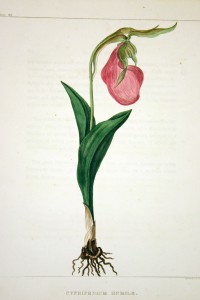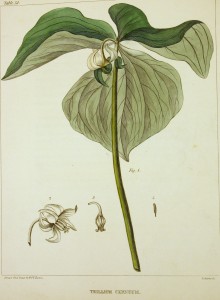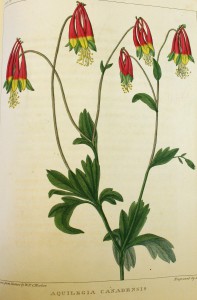Philadelphia: Carey & Lea, 1823. 3 vols.
RARE RES QK112 .B28 1821
Gift of Kenneth and Mary Tisdel

Barton's Flora is an important early American color plate book. Like many other illustrated works of science and natural history of this period, the rich illustrations of Barton’s Flora made the publication expensive to produce. To offset the cost, it was sold by subscription. Subscribers would have bought the book ready-made. Instead, they would have received installments of one or two sections at a time, and would have had their copies bound as the volumes were completed.
Barton’s descriptions of plants include the current Latin name of each species, the names used by the botanists Carolus Linnaeus and Antoine Laurent de Jussieu, and common English names. His discussion also includes growing habits, ranges and habitat, and the history and usages of each plant.
Barton paid particular attention to native orchids, many of which are threatened today. In his description of the ladyslipper orchid (Cypripedium humile), he notes the plant’s fragility:
It is a favorite flower, from the circumstance of its continuing to bloom a long time. It does not, however, bear the soil or atmosphere of common gardens… I have repeatedly attempted to cultivate it, but have never had a plant to bloom a second season.
Although Barton wrote before the main era of westward expansion and thus focused on the eastern United States, he includes wildflowers that also inhabit the midwest. His illustrations of Rudbeckia purpurea, Coreopsis tinctoria, and Aquilegia canadensis may be familiar to Missourians as purple coneflower, golden tickseed, and columbine.

Barton put forward his Flora in order to promote an interest in botany among American scientists and the general public, and he expresses a certain measure of territorialism toward American natural history. In the preface to this book, Barton states that Americans have neglected the study of their own plants and left too much responsibility to European scientists. He cautions the American medical and scientific community against allowing too much of their “extensive domains” to be published by foreign scholars, and he wrote, “Can any American examine the splendid and useful work of the younger Michaux, on our forest trees, without a pang of mortifying regret that the author of such a work was not an American?”

Barton’s attempts to make up for the failures of American naturalists may also have been personal. His uncle, Benjamin Smith Barton, was the most prominent American botanist of the previous generation, but he failed to publish the botanical samples Lewis and Clark brought back from their expedition, and even lost some of them. William Barton’s work was intended as a first step in the advancement of American scientific thought. Considering himself to be embarking on an extensive work of national importance, Barton dedicated the first volume to President James Monroe.
The illustrations for this volume were drawn from nature by Barton, engraved in the workshop of Cornelius Tiebout of Philadelphia, and colored by hand, “its execution being wholly accomplished by American artists.” Barton paid special attention to color; in one of the prefaces of the first volume, he provides color charts with real-world explanations of the terms he uses to describe plants. For example, if the reader did not understand what Barton meant by “duck green,” he or she could look at the neck of a mallard, the upper disk of yew leaves, or the mineral ceylanite to get an idea. Similarly, the term “venous blood red” denoted the color of blood, musk flower, or the mineral pyrope. This attempt at accuracy was important before the invention of color photography.